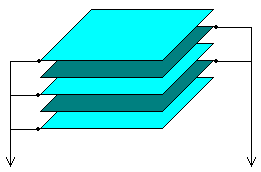
Practical Coilgun Design
Capacitors
Units of Capacitance
The basic unit of capacitance is the farad, but this is much too large for practical work. (Except possibly for car stereos with thundering bass boom boxes!) Capacitance is usually measured in microfarads (abbreviated uF or mfd) or picofarads (pF).
The microfarad is one millionth of a farad (10-6 F), and the picofarad is one-millionth of a microfarad (10-12 F).
To convert between µF and pF and a wide varitety of other units, use the Electric Capacitance Unit Converter.
 Capacitors
nearly always have more than two plates, the alternate plates being connected together
to form two sets, as shown here. This makes it possible to attain a fairly large capacitance
in a small space, since several plates of smaller individual area can be stacked to form the
equivalent of a single large plate of the same total area. Also, all plates except the two on
the ends are exposed to plates of the other group on both sides, and so are twice as effective.
Capacitors
nearly always have more than two plates, the alternate plates being connected together
to form two sets, as shown here. This makes it possible to attain a fairly large capacitance
in a small space, since several plates of smaller individual area can be stacked to form the
equivalent of a single large plate of the same total area. Also, all plates except the two on
the ends are exposed to plates of the other group on both sides, and so are twice as effective.
The electrolytic capacitor uses aluminum-foil plates with a conducting semi-liquid chemical compound between them. The actual dielectric is a very thin film of insulating material that forms on one set of plates through electro-chemical action when a dc voltage is applied. The capacitance obtained with a given plate area in an electrolytic capacitor is very large, because the film is so thin. Much thinner than anything practical with a solid dielectric. However, this also causes the breakdown voltage to be much lower than with solid dielectrics. The electrolyte is necessarily an acid; therefore it is extremely dangerous if heat builds up inside an electrolytic capacitor. It can bulge, leak and even explode. Look carefully at your higher quality electrolytic capacitors, and you may see a scoring mark 'X' at the terminal end which is designed to rupture and leak before the can explodes.
| < Previous | Page 2 of 6 | Next > |
©1998-2024 Barry Hansen